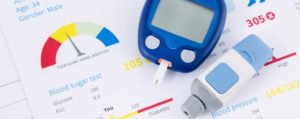 HYANNIS – The combination of genetics, being overweight, unhealthy eating and a sedentary lifestyle is creating what many doctors are describing as an epidemic of diabetes in this country. If the word ‘epidemic’ seems like an exaggeration, consider these recent statistics from the American Diabetes Association:
HYANNIS – The combination of genetics, being overweight, unhealthy eating and a sedentary lifestyle is creating what many doctors are describing as an epidemic of diabetes in this country. If the word ‘epidemic’ seems like an exaggeration, consider these recent statistics from the American Diabetes Association:
- In 2015, 30.3 million Americans had diabetes (up from 25.8 million in 2010).
- Of that group, 7.2 million have undiagnosed diabetes.
- Seniors over 65 are hit particularly hard with 11.8 million (25.9 percent) of people 65 or older having diabetes.
- Every year, 1.5 million Americans are newly diagnosed with diabetes.
- More cases are expected in the future because 84 million Americans age 20 or over have diabetes, which is about one-third of the population.
- In 2015, 84 million Americans over the age of 18 have prediabetes
- Without intervention, 15 to 30 percent of people with prediabetes will develop Type 2 diabetes within five years.
“Both diabetes and prediabetes are exploding in this country,” said Debbie Allietta, RN, a certified diabetes educator for the Visiting Nurse Association of Cape Cod. “We want to identify people that have pre-diabetes to provide education about lifestyle changes to hopefully delay or prevent the development of Type 2 diabetes.”
Type 2 diabetes is a carbohydrate metabolism disorder. When carbohydrate foods are eaten, they turn into glucose to provide the cells of the body with energy. The hormone insulin, secreted by the pancreas acts as a transporter to get glucose into the cells.
People with diabetes have decreased insulin production as well as a condition called insulin resistance. This means the cells of the body cannot use the insulin effectively, which results in high blood glucose levels.
Dangers of Diabetes
The Centers for Disease Control and Prevention list the following complications from unmanaged diabetes:
- High blood pressure
- High LDL cholesterol
- Increased risk of heart attack and stroke
- Blindness and eye problems
- Kidney disease
- Amputation of limbs
- Painful nerve disorders
- Non-alcoholic fatty liver disease
- Erectile dysfunction
- Depression
The symptoms of diabetes, according to Allietta, are:
- Increased urination as your kidneys work harder to rid the body of excess sugar
- Excessive thirst caused by increased urination
- Fatigue because the body isn’t getting the energy it needs
- Wounds or cuts that are slow to heal
- Blurred vision
- Numbness or tingling in the feet
“Many of these symptoms like increased urination or blurry vision are also symptoms of the aging process, so people don’t think about them,” she said. “There’s a huge amount of denial with diabetes because people don’t usually feel signs and symptoms early on, so they do not understand the importance of taking care of their diabetes to avoid long-term complications.”
What Is Prediabetes?
People with prediabetes have blood sugar numbers that are higher than normal, but not high enough to classify as Type 2 diabetes. One of the biggest problems with prediabetes is that there aren’t any clear symptoms, which is why so many people don’t know they have it. Unless a person is getting regular physicals that include a fasting blood sugar test, it is easy to miss even those who have developed actual diabetes.
There is a lot more awareness in the medical field about the dangers of prediabetes than in the general public. Local labs actually flag patients whose blood sugars are in the prediabetes phase so their doctors can discuss the lifestyle changes that can help.
The numbers for a fasting blood sugar levels are as follows:
- 70 to 99 is considered normal
- 100 to 125 is considered prediabetes
- 126 or above on two different tests indicates Type 2 diabetes
The most important thing for people with prediabetes to know is that they may be able to delay or prevent the development of Type 2 diabetes, Allietta said. While there is a genetic component to diabetes, being overweight and sedentary greatly increases the risk of developing it.
Lifestyle Changes Help
The Diabetes Prevention Program was a major clinical research study published in the New England Journal of Medicine in 2002 to see whether 3,234 participants with prediabetes could prevent or delay the onset of Type 2 diabetes with lifestyle or medication.
The study has been updated and is still considered one of the gold standards in diabetes care, according to Allietta. People in the lifestyle intervention group reduced their risk of developing diabetes over three years by 58 percent. Lifestyle intervention was particularly helpful for those over the age of 60, reducing their risk by 71 percent.
Results from the study were so dramatic that the government designed a similar National Diabetes Prevention Program that was funded through the Affordable Care Act. In March of last year, the program was expanded to be covered under Medicare in an effort to save both lives and money.
“I think it’s wonderful and long overdue that Medicare will start covering the program for people with prediabetes,” Allietta said. “We need to be preventing and educating people rather than dealing with it after the fact.”
The study showed that just a 7 percent reduction of weight can decrease blood glucose levels. Allietta said that for some people with pre-diabetes, early intervention and treatment can actually return blood glucose levels back to a normal range.
In addition to weight loss, Allietta said the American Diabetes Association recommends at least 150 minutes of exercise a week. It can be as simple as a brisk walk five days a week, but preferably seven. They also recommend that you don’t miss more than two days in a row.
“Not only does exercise promote weight loss, but it also helps the body use insulin better,” she said. “It decreases insulin resistance so the cells of the body are able to get the glucose from the blood stream more effectively, thus lowering blood glucose levels.”






















